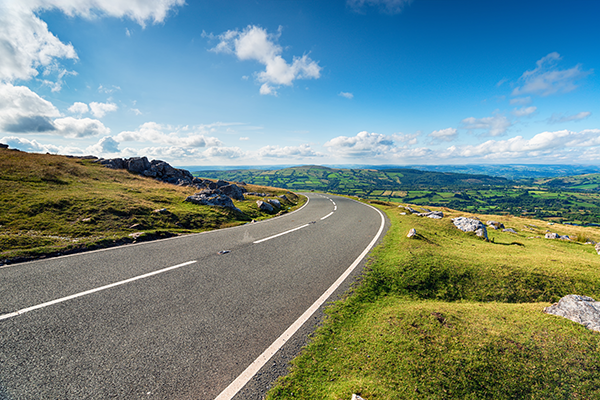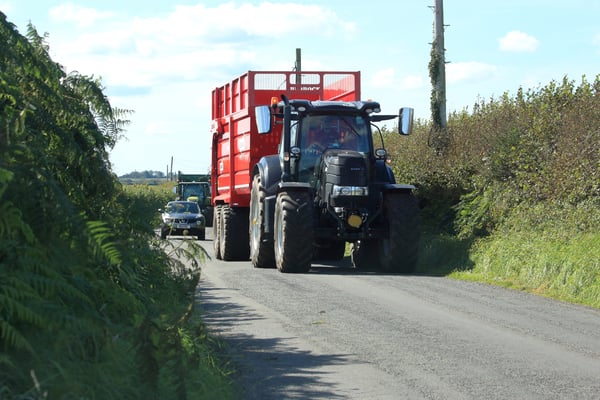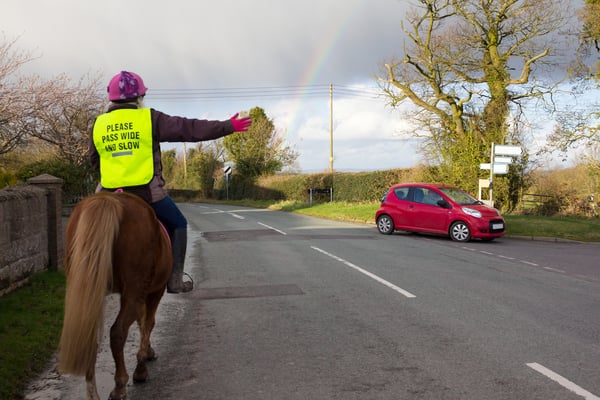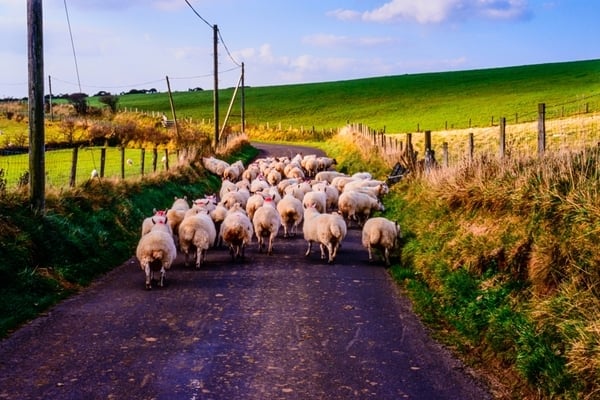New drivers can often find country roads intimidating. Compared to city roads they can be narrow, winding, and dark.
Because of this, there are far more fatal collisions on rural roads than on urban ones.
If you've recently passed your test and want to take on rural roads safely, we've put together some tips and advice about how best to navigate them. 
In this article:
- Speed limits
- Bends, overtaking, and the nature of the road
- Right of way when passing spaces
- Pedestrians, cyclists, tractors
- Livestock on the road
- Lights
- Weather conditions
Speed limits
The national speed limit on a single carriageway is 60 mph. This might be a lot faster than you're used to driving outside of a motorway, but it’s important to remember that this isn't a target speed or a minimum speed. Always drive at a speed you're confident and comfortable with. The maintenance of the roads, the weather, and other road users are all factors that determine how fast you can safely drive.
There's every chance you could suddenly come across pedestrians in the road, cyclists, horse riders, slow-moving farm vehicles or other vehicles turning out of a side road. You need to be driving slow enough to be able to react and respond to every road user.
When it comes to taking a sharp bend in the road, it's particularly important to approach slowly and with caution even if the speed limit is 60 mph.
It can seem daunting driving at a higher speed at first, but with experience, you'll get more confident. Don't feel pressured by other road users to increase your speed if you don't feel safe to. Stay alert and keep trying to see as far down the road as you can.
Bends, overtaking and the nature of the road
When driving on country roads you're often faced with narrow lanes, sharp bends and corners. So you need to be on the constant lookout for what lies ahead.
Learn how to adjust your driving style to be safe:
- On bends lookout for high hedges; they can interfere with your line of sight and your ability to predict the movements of oncoming traffic.
- Use your horn when approaching blind bends to alert other drivers of your presence.
- There might not be any road markings to indicate lanes, so you'll have to judge the width of your car. Always try to stick to the left-hand side of the road.
- Country roads are generally less well maintained than city roads. Look out for potholes and uneven surfaces in the road.
- Be willing to slow down or stop for larger vehicles that you pass coming the other way.
- Don't overtake if you don't need to.
- If you must overtake never attempt to on a corner, if any other road user is going to turn right, or other road users are joining the road from a side road.
- Think twice before overtaking on a hill, it takes longer to pass on an incline and can be dangerous.
- Be aware of your surroundings. If you see a broken fence or debris in the road slow down as you can't be sure what's ahead.
- Always look for warning signs on the road.

Right of way when passing spaces
Navigating country roads can be tricky, as often the roads aren't big enough for both your vehicle and oncoming traffic. You always need to plan ahead and look out for any spaces that you can use if needed.
Other drivers can be unpredictable, but you can try your best to anticipate what they're going to do next. If a vehicle is approaching quickly, then it's likely they want you to wait in a space for them.
If a vehicle is slowing down and moving over to their left, then they probably want you to drive through. If there aren't any spaces on your side but there are on theirs, stop opposite the space and wait for them to pull into it.
If you do move over for oncoming traffic, keep your eyes peeled for potholes, ditches, big branches, or anything that could damage your vehicle.
The key thing to remember is always be mindful of other road users and be ready to respond to them.

Pedestrians, cyclists, tractors
You might find yourself sharing the road with a tractor, animal or heavy vehicle, as well as pedestrians and cyclists when you're driving in the country.
With more green space, the countryside tends to attract heavier vehicles to its roads. People use caravans for holidays, and you might see horseboxes or other heavy vehicles on the roads – just be sure to give them plenty of room.
Tractors move very slowly, but it's likely you won't be stuck behind one for too long. Often tractors only travel short distances on main roads before turning off onto a farm track.
There aren't many pavements on country roads so be on the lookout for pedestrians as they'll often walk next to cars. Most tend to walk on the opposite side of the road for visibility (towards oncoming traffic). Lots of people have dogs in the country, so a lead in a hand can help you spot someone.
Country roads can be tricky for cyclists to navigate, especially as there won’t be cycle lanes. Watch out for big hills which cyclists may struggle to complete. If you do overtake here, slow down and make sure it’s safe before you do.
If you see horse riders on country roads drive slowly and give them as much space you can. Look out for manure in the roads to indicate they may be ahead.
Read more on sharing the road safely with horses.
Livestock on the road
Keep an eye out for signs indicating cattle or wildlife crossing and be extra alert when you're driving in those areas. Be particularly careful during May, October, and November, when accidents involving deer reach a peak.
Find out more about how you can respond to animals on the road and avoid deer collisions.
It's not unusual to get trapped behind a herd of cows or have to wait while a flock of sheep cross the road. You can overtake them if you need to, but make sure you have plenty of room and do it slowly. Don't rev too much or use the horn as you might spook the animals.

Lights
It might be a while since you've studied your car's dashboard but on country roads, it's important to be seen. Make sure you're familiar with all the lights on your car and when to use them.
If you're used to driving in the city you may not have used your full beam headlights. You'll need them in the countryside though as often the roads have few streetlights. When you're on a dark and unlit road using your full beams will help you see the road ahead.
You'll need to switch to dipped headlights if you see oncoming traffic (full beam lights can harm the vision of other road users).
Even if it's not dark, it can be useful to turn on your dipped headlights - so that other drivers can see your vehicle.
Get comfortable with switching being dipped headlights to full beam safely - being careful not to dazzle anyone while doing so.
Never use your full beams if you are driving in fog, rain, or snow. In these conditions they can make your vision worse and reflect a bright light back to you, giving you a glare.
Weather conditions
Plan your route before setting off based on weather conditions for the day. If there's bad weather avoid country roads where possible. You're safer sticking to main roads as they're more likely to be gritted if it's icy, while country roads may have fallen branches, flooded dips, and deep snow or ice that could cause accidents. Rural roads are prone to flooding, and mud on the roads can be slippery when wet, so always drive cautiously.
Get more seasonal advice on driving in different weather conditions.
